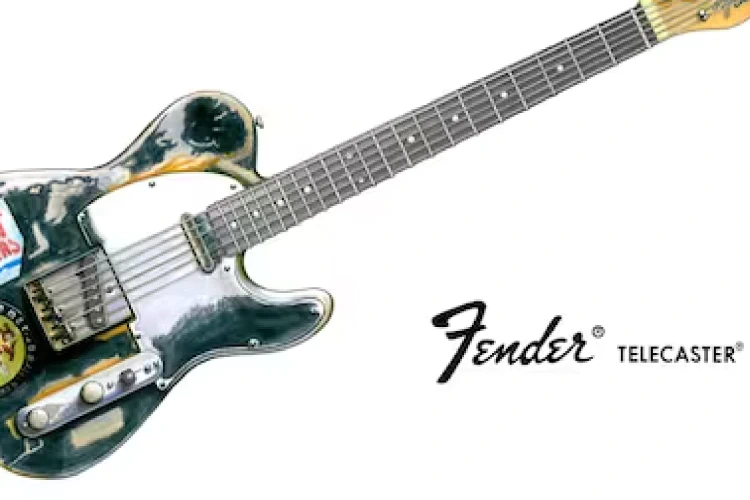Tele Trivia: 20 Lesser-known Facts About the Iconic Fender Solidbody
The Fender Musical Instruments Corporation created and manufactured the Fender Telecaster electric guitar model in the 1950s. The likes of Johnny Cash, Merle Haggard, and Bruce Springsteen have all played it, making it one of the most played guitars in history. Here are a few intriguing Telecaster-related facts:
The Telecaster, the first solid-body electric guitar to be mass-produced, was initially intended as a more cost-effective alternative to other electric guitars available on the market at the time.
The Telecaster is a straightforward, practical instrument with a single cutaway body and two single-coil pickups that provide a bright, twangy sound that has been employed in a wide range of musical genres, including country, rock, and blues.
Musicians who were used to the warmer, more mellow tone of hollow-body electric guitars were originally skeptical of the Telecaster. However, it immediately became well-liked by musicians who admired its distinctive sound and adaptability.
Over the years, the Telecaster has seen a number of design modifications, including the inclusion of a second pickup, a contoured body, and a number of color and finish variations. But since the guitar’s invention, its fundamental form has mostly stayed constant.
Over the years, several well-known musicians have played the Telecaster, including Jeff Beck, Keith Richards, and Muddy Waters. It is also a favorite of many modern musicians, and it is frequently employed in a range of musical genres, from jazz and punk to rock and blues.
It is challenging to state what most people do not know about the Fender Telecaster guitar because it is a well-known and frequently utilized instrument. Here are some lesser-known details about the Telecaster, though:
Leo Fender, the creator of the Fender Musical Instruments Corporation, did not create the Telecaster as his first electric guitar. His first electric guitar, the Fender Esquire, which was essentially a single-pickup Telecaster, was released in 1950.
The initial Telecaster prototypes were constructed with leftover pieces that Fender had laying around his workshop. The neck of a lap steel guitar was used on the body, which was constructed from a piece of pine.
The metal pickguard was required by the Telecaster’s initial design in order to ground the electronics and lessen interference. Fender switched to a plastic pickguard after rapidly realizing that the metal one made the guitar overly heavy.
The rival guitar manufacturer Gretsch asserted that they had already patented the word, forcing Fender to modify the Telecaster’s name from the original “Broadcaster.” The guitar was originally called the Broadcaster until Fender made the simple decision to drop the “Broad” from the name.
The Telecaster wasn’t an instant hit when it was originally released, despite its popularity. The guitar took some time to become widely used by musicians, and it wasn’t until the 1960s that it firmly established itself as an iconic instrument.
A guitarist may prefer a Fender Telecaster for a number of reasons. Among the most popular explanations are:
The Telecaster can be used in a wide range of various musical genres despite having a distinctive, twangy tone that is frequently associated with country and blues music.
The Telecaster boasts a straightforward, practical design that is portable and simple to use. All skill levels of players can comfortably use it thanks to its single-cutaway body and smooth, thin neck.
The Telecaster is renowned for being dependable and long-lasting. Its solid-body design makes it more durable than other styles of electric guitars and able to survive extensive use.
The Telecaster is a flexible guitar that works well in a variety of musical contexts. The guitar’s two pickups enable players to vary between a range of tonal possibilities, and its bright, punchy sound is well suited to lead and rhythm playing.
The Telecaster is a well-liked option among guitarists who wish to replicate the sound of their heroes because it has a long history and has been played by many well-known performers. Many players appreciate the feeling of playing a guitar with such a deep history because of its instantly recognizable shape and distinctive sound.
The Fender Telecaster has some cons despite being a well-liked and respected guitar. The following are a few possible difficulties of using a Telecaster:
Because of its unique tone, the Telecaster may not be appropriate for many musical genres. Its twangy, bright tone works well for rock, blues, and country music, but it might not be as adaptable as other electric guitars for jazz or metal.
The Telecaster only has two pickups, which may restrict the player’s tonal options. Due to this, achieving certain sounds may be difficult, and using external effects pedals may be necessary to provide a larger variety of tones.
Some musicians who prefer guitars with more sophisticated features, like as numerous pickups, tremolo bridges, or built-in electronics, may view the Telecaster’s relatively straightforward construction and lack of frills as a drawback.
The Telecaster’s bridge is fixed, therefore the strings cannot be independently adjusted. This can make it challenging to properly set up the guitar and, if the strings are not aligned, can result in intonation problems.
When played loudly, the Telecaster is susceptible to feedback, especially when utilizing the bridge pickup. It may be necessary to employ specialized methods or tools to control the feedback if you play the guitar in noisy, live environments.
